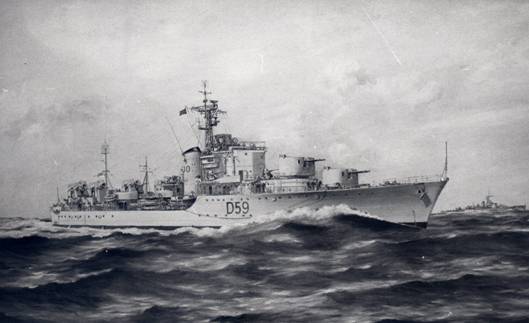- Author
- A.N. Other and NHSA Webmaster
- Subjects
- History - general, Ship histories and stories
- Tags
-
- RAN Ships
- HMAS Anzac II
- Publication
- March 2011 edition of the Naval Historical Review (all rights reserved)
With the end of World War II in sight the RAN had to plan for replacement ships of its hard worked destroyer force. The remaining ‘V&W’ destroyers HMA Ships Vendetta and Stuart were obsolete and worn out. The effective ‘N’ class had been returned to the Royal Navy and their replacement ‘Q’ class were inadequate for post-war requirements. In keeping with tradition of using Admiralty designs, the Naval Board considered the RN ‘Battle’ class destroyers as suitable replacements, and government approval was forthcoming to build two ships modified to RAN standards. One ship was to be built at Williamstown Naval Dockyard and the other at Cockatoo Island Dockyard.
Originally the names of these ships were intended to commemorate recent World War II Australian naval actions with the names ‘Tobruk’ and ‘Matapan’ selected. While the former name was retained, a decision was made to rescind the second in favour of ‘Anzac’.
‘Battle’ Class Destroyers
The ‘Battle’ class destroyers were built in Britain in two groups. Group 1 of sixteen ships commenced construction in 1942, with Group 2 of eight ships laid down from 1943. A further Group 3 of eight ships was intended in 1944 but with the end of World War II in sight the Admiralty cancelled these orders. However two ships of Group 3 were built by the RAN. Two of the RN ships were subsequently transferred to other navies, one to Pakistan and another to Iran.
The 1942 ‘Battles’ were a new class of Fleet Destroyers designed to operate within a Fleet environment and provide anti-submarine and anti-aircraft support. The original armament comprised two twin 4.5 inch Mark IV turrets; four twin 40mm Hazemeyer Bofors (one on each bridge wing and two on the centreline aft); one single 4 inch Mark XXIII (Starshell) gun; and two single 2 pounder pom poms Mark XV or Mark XVI. There were two sets of pentad (5) torpedo tubes as well as depth charge throwers. The depth charges were later removed when the SQUID ahead-throwing mortar was developed. The mortar was sited on the quarterdeck and fired its charges over and ahead of the ship, thereby maintaining improved contact with underwater targets. In earlier versions of the ‘Battles’ the single Bofor mounting on the quarterdeck had to be removed to make way for SQUID.
Construction in Australia
Anzac and her sister HMAS Tobruk were the first major warships constructed in Australia after World War II, and at that time the largest destroyers and most complicated fighting ships ever constructed in this country. Local modifications included upgrading the main armament to two twin Mark VI turrets as opposed to the Mark IV DP (Dual Purpose) turrets fitted in the RN ships, and the gunnery control system was upgraded from Flyplane Mk 1 to Flyplane Mk II, noting that the RAN ships were the only ships with this system, as later ships had the much improved Flyplane Mk III. Improvements were also made to habitability, with better ventilation and higher standards of accommodation.
Anzac was laid down at Williamstown Naval Dockyard on 23 September 1946 and was launched on 20 August 1948 by Mrs Collins, wife of the First Naval Member Rear Admiral J.A. Collins, RAN. She commissioned on 14 March 1951 under Commander J. Plunkett-Cole, RAN, who was also appointed Commander of the 10th Destroyer Flotilla. In the same timeframe her sister ship Tobruk was being built at Cockatoo Island Dockyard.

Image courtesy of RAN
Korea
After workup Anzac joined the United Nations Forces in Korea in August 1951. On arrival in Korean waters she teamed up with Tobruk and the ‘River’ class frigate HMAS Murchison. Her first operation on 6 September was a bombardment of Haeju on the west coast, north of the 38th Parallel. Targets included a two storey building believed to house the headquarters of local North Korean forces, as well as a gun emplacement. The shore facilities were left a smoking ruin with many casualties.
Her next patrol was carried out on the east coast off Songjin, just south of the Korean-Chinese border. The mission to harass rail and road traffic was successful, with direct hits on at least one train. She was also involved in guerrilla style operations, landing South Korean Marines to gather intelligence.
After steaming some 23,000 nautical miles on operations in Korean waters, Anzac returned to Sydney in October 1951, having escorted the light fleet carrier HMS Glory to Sydney for refit.




